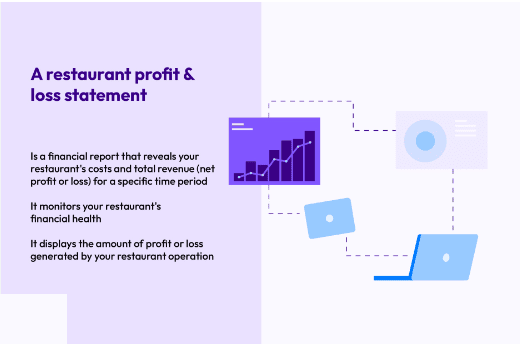How to Read a Restaurant P&L – Latest Guide

Hey there,
If you were wondering,
How to Read a Restaurant P&L,
You are in the right place.
Here, I’ll walk you through deciphering the P&L statement for your eatery (P&L). Tackling such an important financial document may be daunting, but don’t worry; I’ll show you precisely what to do. You’ll be able to read your restaurant’s profit and loss statement like a pro by the time you’re done reading this piece.
Let’s dive right in.
How to Read a Restaurant P&L
How to Read a Restaurant P&L? To analyze a restaurant’s profit and loss statement effectively, it is crucial to compare the actual figures with the budgeted or projected numbers, as well as with industry benchmarks or previous periods. This practice allows for identifying gaps, trends, or issues that require attention. For instance, reviewing inventory levels, portion sizes, waste management, and supplier prices is advisable if your food cost exceeds expectations.
On the other hand, if your labor cost is lower than expected, consider evaluating staff performance, morale, or turnover. By employing these strategies, you can better understand the financial health of your establishment and make informed decisions to optimize its success.
What is a Restaurant P&L Statement?
What is a Restaurant P&L Statement? Profit and loss statements (P&L statements) are financial documents detailing your restaurant’s income and expenditures for a given period, often one month or year.
It’s a snapshot of your restaurant’s financial performance, helping you understand whether you’re making a profit or experiencing a loss. Reading and understanding your restaurant’s profit and loss statement is essential for making data-driven decisions that can lead to the growth and success of your restaurant.
Understanding Restaurant P&L Statement

Key Components of a Restaurant Profit and Loss Statement
A standard restaurant P&L statement consists of the following components:
Revenue: This section shows the total sales generated by your restaurant during the reporting period.
Cost of Goods Sold (COGS): This section details the cost of the ingredients and materials used to make your food and beverages.
Gross Profit: This is the difference between your revenue and COGS. It shows how much money you have left after covering the cost of producing your menu items.
Operating Expenses: This section lists all the expenses of running your restaurant, such as labor, rent, utilities, and marketing.
Net Income: This is the final result, showing whether your restaurant made a profit or experienced a loss during the reporting period.
Understanding Revenue

Your restaurant’s revenue is the total money from selling food and beverages. Tracking this figure regularly is essential to identify trends and monitor your restaurant’s performance. To calculate your revenue, add all your sales for the reporting period.
Revenue can be broken down into subcategories, such as:
- Food sales
- Beverage sales
- Catering sales
- Gift card sales
Breaking down your revenue allows you to see which areas of your business are performing well and which might need improvement.
Analyzing Cost of Goods Sold (COGS)
COGS represents the direct costs of producing the food and beverages you sell. It includes the cost of raw ingredients, packaging materials, and other supplies to prepare and serve your menu items. To calculate COGS, you’ll need to track your inventory levels and monitor the cost of each ingredient.
COGS can be broken down further into subcategories, such as:
- Food COGS
- Beverage COGS
Understanding your COGS allows you to identify areas where you can cut costs, increase efficiency, and ultimately improve your restaurant’s profitability.
Calculating Gross Profit
Net sales are subtracted from COGS to determine gross profit. This is how much money is left over after paying for the materials and labor necessary to make your food. Your gross profit margin, or the amount of money made more than what was brought in, is a key metric to monitor. If your restaurant has a high gross profit margin, it does well financially.
Reviewing Operating Expenses
Operating expenses are the day-to-day costs of running your restaurant, such as labor, rent, utilities, marketing, and insurance. These costs can be fixed (i.e., they don’t change with sales volume) or variable (i.e., increase or decrease with sales volume).
Understanding and monitoring your operating expenses is essential to manage costs effectively without overspending on any particular area.
Operating expenses can be broken down into several subcategories, such as:
Labor: This includes salaries, wages, and benefits for your employees.
Rent: The cost of leasing your restaurant space.
Utilities: Expenses like electricity, water, and gas.
Marketing: Costs associated with advertising and promoting your restaurant.
Insurance: The cost of insurance policies, such as general liability and workers’ compensation.
Maintenance: Expenses related to maintaining and repairing your restaurant’s equipment and facilities.
Miscellaneous: Other expenses that don’t fit the above categories, like professional fees, licenses, and permits.
Calculating Net Income
Net income is the final result of your restaurant’s P&L statement, showing whether your restaurant made a profit or experienced a loss during the reporting period. Net income is obtained by deducting operational costs from gross profit.
A positive net income indicates that your restaurant is profitable, while a negative net income signifies a loss. Regularly tracking your net income can help you identify trends in your restaurant’s financial performance and make adjustments to improve profitability.
Net Income: The Bottom Line
To calculate your net income, follow these simple steps:
- Determine your gross profit: Subtract your Cost of Goods Sold (COGS) from your total revenue.
- Calculate your total operating expenses: Add up all the costs of running your restaurant, such as labor, rent, utilities, marketing, and more.
- Get your net profit by deducting your operational costs from your gross income. Your take-home pay can be calculated in this way.
Interpreting Your Net Income
A positive net income indicates that your restaurant is profitable, while a negative net income signifies a loss. By regularly tracking your net income, you can identify trends in your restaurant’s financial performance and make adjustments to improve profitability. Here’s how to interpret your net income:
- Positive net income: Congratulations! Your restaurant is turning a profit. This is a sign that your business is on the right track, but it doesn’t mean you should become complacent. Continuously evaluate your restaurant profit and loss statement and look for opportunities to increase revenue further or reduce costs.
- Negative net income: If your restaurant is experiencing a loss, it’s time to review your P&L statement and identify improvement areas. This could involve reducing labor costs, renegotiating vendor contracts, or revamping your marketing strategy. Remember, a negative net income is a red flag, but it doesn’t necessarily spell doom for your restaurant. You can turn things around and move toward profitability by taking swift action.
Using Net Income to Identify Trends and Make Informed Decisions
By closely examining your net income, you can identify trends and patterns in your restaurant’s financial performance. For example, if your net income has steadily decreased over several months, it’s essential to investigate the root cause and address any issues.
Additionally, keep an eye on your net profit margin, which is your net income as a percentage of your total revenue. This ratio helps you gauge the overall profitability of your restaurant and compare it to industry benchmarks. A low net profit margin could indicate inefficiencies or other problems that must be addressed.
Analyzing Your Restaurant P&L Statement

Now that you understand the components of a P&L statement, it’s time to analyze the data and draw insights that can help you improve your restaurant’s financial health. This comprehensive guide on “How to Read a Restaurant P&L” will delve deeper into various tips and strategies for effectively analyzing your P&L statement.
Set a Regular Schedule for Reviewing Your Restaurant P&L Statement
Consistency is key when it comes to analyzing your P&L statement. Set a regular schedule for reviewing your restaurant’s P&L statement, whether monthly, quarterly, or annually. This will help you identify trends and changes in your restaurant’s financial performance over time, allowing you to make informed decisions based on historical data.
Utilize Financial Ratios
Financial ratios are valuable tools that help you better understand your restaurant’s financial performance. Some key financial ratios to calculate and track include:
a. Gross Profit Margin: Gross Profit / Revenue b. Net Profit Margin: Net Income / Revenue c. Labor Cost Percentage: Labor Costs / Revenue d. Food Cost Percentage: Food COGS / Food Sales
By tracking these ratios over time, you can identify areas of your business that may need improvement and monitor your progress as you implement changes.
Compare Your Performance to Industry Benchmarks
When analyzing your P&L statement, comparing your restaurant’s financial performance to industry benchmarks is helpful. Doing so lets you see how your restaurant compares to others in the industry and learn how to improve any weak spots. Some standard industry benchmarks include average profit margins, labor cost percentages, and food cost percentages.
Identify Areas for Cost Reduction
As you analyze your P&L statement, look for areas where you can reduce costs without sacrificing the quality of your product or service.
This might include renegotiating contracts with suppliers, reducing food waste, or finding more efficient ways to schedule labor. Reducing costs can improve your restaurant’s bottom line and increase profitability.
Analyze Revenue Streams
Break down your revenue streams to identify which areas of your business generate the most profit. This can help you focus your marketing and operational efforts on the most profitable segments of your restaurant, ultimately leading to increased revenue and profitability.
Monitor the Impact of Changes
It is critical to track how your restaurant’s bottom line responds to any adjustments made in light of your profit and loss analysis. Track your financial ratios and key performance indicators (KPIs) to see whether your changes lead to profitability, efficiency, or revenue generation improvements.
Involve Your Team
Your restaurant’s financial success is a team effort. Share your P&L analysis with key team members, such as managers and chefs, to help them understand the financial implications of their decisions and actions. Please encourage them to contribute ideas for improving your restaurant’s financial performance and work together to implement changes to increase profitability.
Comparing Restaurant P&L Statements Across Periods
One of the best ways to identify trends in your restaurant’s financial performance is by comparing your current P&L statement to previous periods. This can help you spot patterns and changes in revenue, COGS, operating expenses, and net income.
To do this, gather your P&L statements from the past several months or years and examine the data side by side. Look for any significant shifts in the numbers or percentages and try to pinpoint potential reasons for these changes. This process can help you identify areas of concern or opportunities for growth in your restaurant’s financial performance.
Calculating Key Financial Ratios
Analyzing key financial ratios can provide a deeper understanding of your restaurant’s financial health. Here are three essential ratios you should calculate when analyzing your P&L statement:
- Gross Profit Margin: This ratio measures the percentage of revenue that remains after subtracting COGS. A higher gross profit margin indicates better efficiency and profitability. Gross profit margin (%) is calculated by multiplying the gross profit (after expenses) by the total revenue (before deductions).
- Net Profit Margin: This ratio shows the percentage of revenue that remains as profit after accounting for all operating expenses. A better indicator of a restaurant’s success is its net profit margin. To determine your net profit margin as a percentage, take your net profit and divide it by your total sales.
- Labor Cost Percentage: This ratio represents the percentage of your revenue that goes towards labor costs, including wages, salaries, and benefits. A lower labor cost percentage indicates better labor efficiency. To calculate your labor cost percentage, divide your total labor costs by total revenue and multiply by 100 to get the percentage.
Tracking these ratios over time can gain valuable insights into your restaurant’s overall financial performance and efficiency.
Benchmarking Your Financial Performance
To truly understand your restaurant’s financial health, it’s essential to benchmark your financial performance against industry averages. This allows you to see how you stack up against your competitors and identify areas where you may be underperforming or outperforming the industry.
To find industry benchmark data, consult resources like the National Restaurant Association or industry-specific publications. Compare your financial ratios to these benchmarks to determine how well your restaurant is performing about others in the industry.
Identifying Opportunities for Improvement
As you analyze your P&L statement, watch for areas where you can cut costs, increase efficiency, or boost revenue to improve your restaurant’s profitability. Some potential areas to explore include:
- Reducing food waste and optimizing portion sizes to lower COGS.
- Streamlining kitchen processes and staff training to increase efficiency.
- Implementing creative marketing strategies to drive revenue growth.
- Modifying current vendor relationships or replacing them with more cost-effective alternatives.
- Creating Actionable Plans and Monitoring Results
Once you’ve identified opportunities for improvement, create actionable plans and set measurable goals to achieve them.
Regularly review your restaurant profit and loss statement to track your progress and make adjustments as needed.
Keeping on top of your restaurant’s financial performance and paving the way for sustained success requires continual analysis, goal-setting, and monitoring.
Unlocking Restaurant Profit Secrets – Explore More in the Video Below
Frequently ASKED Questions
How do you read a P&L for dummies?
Reading a P&L statement is simpler than it seems, To initiate your analysis, start by evaluating the gross profit, which is obtained by deducting the cost of goods sold from your total revenue.Then, glance at the expenses section to see the total money spent during a specific time frame. Lastly, the net operating income is calculated by subtracting total expenses from the gross profit. It’s like peeking behind the financial curtains of your company!
How is restaurant profit calculated?
Calculating restaurant profit is just a matter of some quick math. To calculate your net revenue for a specific period, subtract the total cost of goods sold (COGS) from your overall revenue. Consider all the food, beverages, and merchandise you have sold when determining this. Voila, you’ve got your restaurant’s gross profit!
What does a typical P&L look like?
A typical P&L statement starts with a revenue entry, commonly called the top line. From there, you subtract all the business costs, including operating and tax expenses, and the cost of goods sold. The final figure, the bottom line, represents your net income, actual profit, or earnings.
What are the three most important parts of a P&L?
In a P&L statement, you’ll focus mainly on three sections: revenues, COGS, and operational expenses. These categories will encompass every entry on the P&L statement, playing a crucial role in determining the ultimate bottom line of your business.
What are the five key components to a P&L statement?
The P&L statement breaks down into five crucial segments: Revenues, Cost of Goods Sold, Gross Profit, Operating Expenses, and Operating Income, followed by other income and expenses that finally lead to the net profit. Each segment offers insights into your business’s financial health.
What is the most important part of the P&L statement?
The star of the P&L statement is undoubtedly the Net Income. It’s the tell-tale sign of your business’s success and sustainability over time, illustrating your actual profit. Essentially, you want this figure to be positive or “in the black,” signaling a thriving business.
How do you summarize a P&L statement?
A concise summary of a P&L statement boils down to three parts: Revenue (the income generated from sales), Expenses (the money spent), and Total Income (the final financial gain). It’s a brief rundown of your business’s financial narrative.
What is revenue on P&L statement?
On a P&L statement, the revenue, perched at the top line, represents the net sales from goods or services, accounting for returns, discounts, and other adjustments made during the sales process.
What questions should I ask a P&L?
While analyzing a P&L, consider asking: What do the revenue trends reveal about business health? Are labor costs market-appropriate? Is the technology expenditure fitting for your business model? These questions can guide a fruitful walk through your income statement.
How often should you look at P&L?
You should scrutinize the P & L statement monthly, quarterly, and during tax season. This regular check helps capture a snapshot of your company’s financial performance, allowing for strategic plans to maximize revenue.
What are two key features of a profit and loss statement?
A P & L statement includes all sales (even credit sales pending payment) and all incurred but unpaid expenses. The final figure, obtained by subtracting expenses from earnings, represents your net income, indicating profit if positive.
How to read an income statement?
To read an income statement, start from the top line, showing your total revenue before expenses, and work down to the bottom line, which showcases the net profit after all expenses have been deducted. It’s a clear path from your initial earnings to your final profit.
How do you project a P&L statement?
Projecting a P&L statement involves a five-step journey: Start with an accurate, current P&L statement, predict based on current growth rates, incorporate impacts of planned initiatives, calculate and add anticipated expenses, and finally project both gross and net profit. It’s a roadmap to forecasting your business’s financial future.
Conclusion: How to Read a Restaurant P&L
Reading and understanding your restaurant’s P&L statement is essential for any restaurant owner. By mastering this financial document, you’ll be better equipped to make data-driven decisions that can lead to the growth and success of your restaurant.
Regularly reviewing your P&L statement and taking action based on your analysis can help you maintain a profitable and successful restaurant. So, don’t be intimidated by the numbers – embrace them and watch your restaurant thrive.
With this in-depth guide on “How to Read a Restaurant P&L,” you now have all the information you need to analyze your restaurant’s financial performance and make informed decisions. Happy analyzing, and good luck with your restaurant venture.
Jeff Smith is a Restaurant Consultant with over 20 years of hospitality experience, from server to owner to general manager. He focuses on Restaurant POS technology as well as restaurant marketing. Check out our world-famous restaurant resources page for a comprehensive offering of hand-picked resources and tools to help your business. You can also check out some of our other restaurant business articles.


